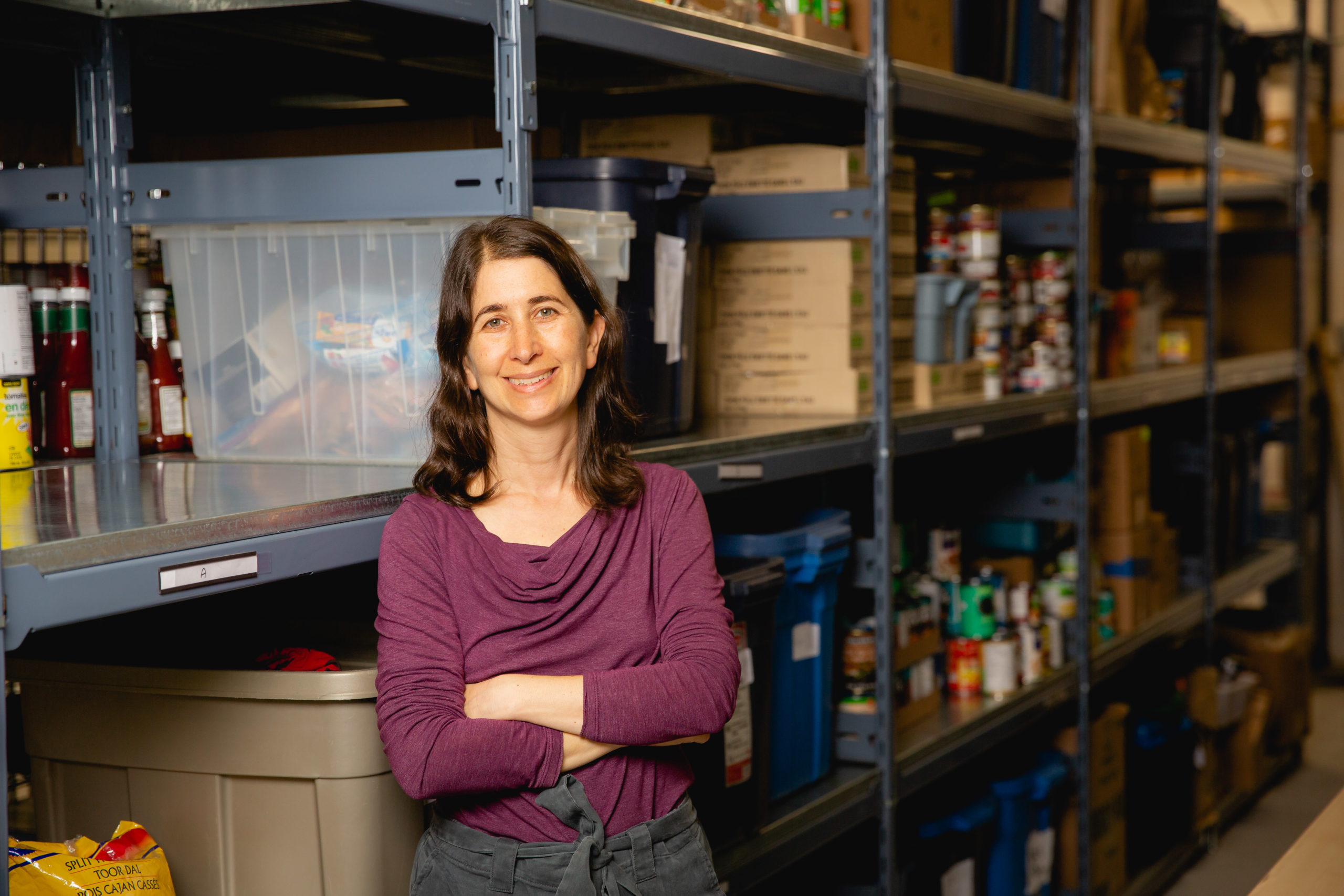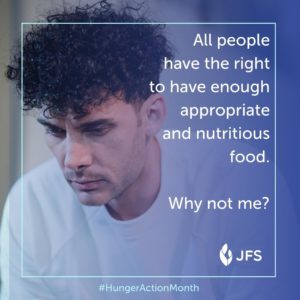It's Hunger Action Month! This is the perfect time to learn more about food insecurity, its impact on communities, and steps that each of us can take to address this problem.
“Saving our planet, lifting people out of poverty, advancing economic growth…these are one and the same fight.” — Ban Ki-moon, Eighth Secretary-General of the United Nations
Hunger is a world-wide problem that affects all of us. It isn’t tied to the amount of food available in the world or our community—it is caught up in who has access to the food and who doesn’t. In most regions, having access means having money.
At the end of 2021, around 2.3 billion people in the world (29.3%) were moderately or severely food insecure – 350 million more compared to before the COVID-19 pandemic. Of that number, nearly 924 million people (11.7% of the global population) were severely food-insecure, an increase of 207 million in two years.
Across the 10 provinces, 5.8 million Canadians, including 1.4 million children, lived in food-insecure households in 2021. This number doesn’t include people living on First Nations reserves, in remote regions, or in the territories, or people experiencing homelessness, all of which have a higher than average rate of food insecurity.
Food insecurity is a serious physical and mental health problem globally and here in BC.
What is food insecurity? And who is at risk?
The right to food is enshrined in the UN Declaration of Human Rights. In recent decades, the UN clarified that the right to food includes being accessible, affordable, adequate to the individual’s dietary needs, and culturally acceptable.
Food insecurity happens when we are missing reliable access to a sufficient quantity of affordable, nutritious food. The world produces enough food to feed everyone; in most regions of the world, including Canada, the main barrier to accessing that food is a lack of money.
Since food insecurity is a direct consequence of poverty, the most vulnerable households are those relying on government assistance, those with insecure incomes, and those with limited or no access to financial assets. Population groups who face systemic discrimination and racism, and that have limited access to education and wealth are disproportionately affected by food insecurity.
Depending on its severity, food insecurity looks like: worrying about running out of food, compromising quality and/or quantity, missing meals, and at the most extreme going a full day(s) without eating, all due to a lack of money for food.
Is food insecurity a Canadian problem?
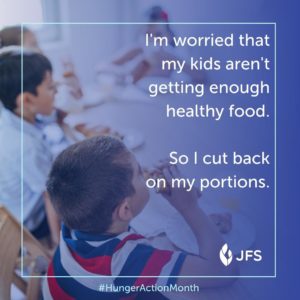 In a Canada-wide April 2022 poll, one in five Canadians say they are likely or somewhat likely to use a food bank or get help from other community food resources.
In a Canada-wide April 2022 poll, one in five Canadians say they are likely or somewhat likely to use a food bank or get help from other community food resources.
The poll also showed that 1 in 4 adults are eating less than they believe they should because there wasn’t enough money for food. Because of the stigma attached to community food programs, most people will make changes like eating less than they should or eating cheaper, lower-quality foods instead of accessing emergency food resources.
In the years immediately before the COVID pandemic, Canadian emergency food programs (e.g., food banks) use had stabilized and food insecurity was decreasing overall. With COVID-related layoffs and again when CERB ended, emergency food program use increased again.
This year, food security programs in Canada are experiencing even higher use than during the 2008 Recession. Across Canada, food banks and other emergency food security programs, including JFS, are struggling to keep up with the increased demand for their services.
This is a problem that affects wholes communities across all of Canada.
How does food insecurity impact health?
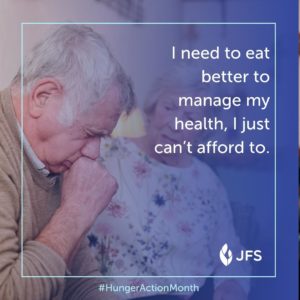 People experiencing food insecurity have more negative health outcomes in both the short and long term. People who are food insecure are more vulnerable to infectious diseases and injury. In the long term, people experiencing food insecurity are at an increased risk of chronic conditions, like depression and anxiety disorders, diabetes, heart disease, hypertension, arthritis, back problems, and chronic pain, and have a higher likelihood of being diagnosed with multiple chronic conditions.
People experiencing food insecurity have more negative health outcomes in both the short and long term. People who are food insecure are more vulnerable to infectious diseases and injury. In the long term, people experiencing food insecurity are at an increased risk of chronic conditions, like depression and anxiety disorders, diabetes, heart disease, hypertension, arthritis, back problems, and chronic pain, and have a higher likelihood of being diagnosed with multiple chronic conditions.
Food insecurity also makes it harder for people to manage existing conditions, for example, not being able to eat food that is appropriate for their health condition, or reducing or skipping medication due to cost.
Adults in severely food-insecure households have the most severe negative health outcomes.
What is the Role of Emergency Food Programs?
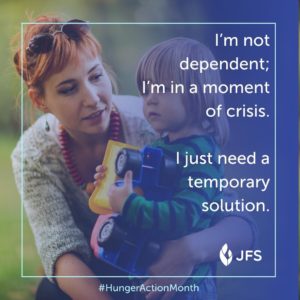 Usually, food banks are a last resort. People experiencing food insecurity will usually use up their cash reserves and other resources before accessing an emergency food program in their community. Most people would rather be able to provide for themselves and their families and communities -- when they're out of crisis, many former recipients of food assistance become donors or volunteers!
Usually, food banks are a last resort. People experiencing food insecurity will usually use up their cash reserves and other resources before accessing an emergency food program in their community. Most people would rather be able to provide for themselves and their families and communities -- when they're out of crisis, many former recipients of food assistance become donors or volunteers!
However, poor social policy means that some people do need to use emergency programs for years in order to meet their needs. As social and disability assistance fails to keep up with the cost of living, people who are unable to access work are forced to find other means of providing for themselves. Better social policies that increase access to sufficient amounts of nutritious food would result in fewer people who need to use emergency resources on a long-term basis.
As an emergency resource, food security programs can prevent a greater strain on the medical system. People experiencing food insecurity have an increased risk of chronic diseases and more negative short and long-term health outcomes. Making sure that everyone has access to enough nutritious food results in a healthier population.
How Do We Prevent Food Insecurity? And what is Food Justice?
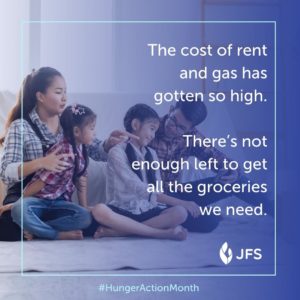 The reason for accessing food services is changing: high inflation, gas, and food prices, and the increasing cost of housing are making people run out of money to spend on food. Wages and social/disability assistance have not kept up with the increased cost of living over the past decades, and that is taking its toll in the form of food insecurity.
The reason for accessing food services is changing: high inflation, gas, and food prices, and the increasing cost of housing are making people run out of money to spend on food. Wages and social/disability assistance have not kept up with the increased cost of living over the past decades, and that is taking its toll in the form of food insecurity.
Food Justice is not only about ensuring that everyone is able to access enough food to eat now, but also advocating for the radical changes necessary in order for everyone to have a voice in our food system.
You can make a difference by advocating for a more just and resilient food system; one that stops food insecurity before it starts. Find out what steps are being taken in your area and support policies to end the housing crisis and ensure a living wage. Keep reading for links to specific actions!
At a federal level, Food Banks Canada have five key policy recommendations to reduce food insecurity by addressing the root causes: low incomes and poverty. Their policies are particularly targeted at those demographics who are at highest risk of food insecurity.
-
- New supports for renters living with low incomes.
- Modernize and expand supports of low wage and unemployed workers.
- A minimum income floor at or above the official poverty line.
- Increase supports for low-income single adults.
- Enhance measures to reduce Northern food insecurity.
What is a Community Food Hub?
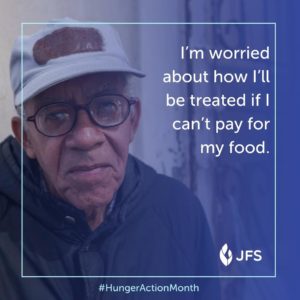 JFS is moving towards a Community Food Hub model so that people can access food resources with dignity. Dignified access to food starts with recognizing that food insecurity isn’t the client’s fault. Food Dignity also means that we don’t make people ‘prove’ that they can’t afford to buy enough food or that they’re hungry.
JFS is moving towards a Community Food Hub model so that people can access food resources with dignity. Dignified access to food starts with recognizing that food insecurity isn’t the client’s fault. Food Dignity also means that we don’t make people ‘prove’ that they can’t afford to buy enough food or that they’re hungry.
The groceries JFS provides include many of the high-cost, nutrient-dense foods that are the first items that families cut back on to try to make their grocery budget last. Yogurt, eggs, and fresh fruits and veggies make up a large portion of the grocery items distributed. Clients are able to choose food that fits their needs, and are treated with respect and confidentiality.
The JFS Kitchen is not meant to be a place where only those ‘without’ go – rather, it is a social hub that supports the myriad food security needs of the entire community by providing access to supportive services alongside food-oriented activities such as gardening, cooking, sharing meals and hosting gatherings.
How Can You Be Part of the Solution?
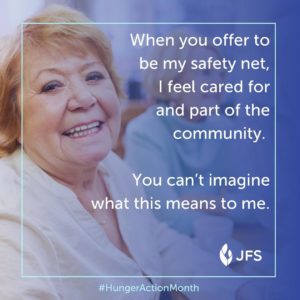 Your actions can make a big difference! There are so many ways that you can help improve food security for everyone.
Your actions can make a big difference! There are so many ways that you can help improve food security for everyone.
- Strengthen the community’s safety net:
-
- Donate to JFS’ Project Isaiah, our annual food drive to stock our Food Pantry;
- Sign up to become a JFS volunteer and share your time and talents with the community!
- Help to cultivate a healthy and resilient food system:
-
- Support local infrastructure to produce, supply and distribute food, like the Farm-to-Plate Marketplace;
- Support local food producers;
- Support food literacy programs.
- Advocate for local, provincial, and federal policies to end the housing crisis and ensure a living wage and minimum income floor:
- Email your MP to tell them you want the government to invest in progressive, equitable income policies that make life more affordable for everyone.
- Sign the petition for an immediate implementation of the Canada Disabilities Benefit.
- Keep learning about food security, what needs to happen to improve it, and the steps that are already in place across our community and the rest of Canada!
-
- Stay up to date on JFS’ work to address food insecurity in our community. Sign up for our e-newsletter and follow us on Facebook, Instagram, and Twitter.
- Then, check out these great resources to learn more:
Sources:
Black, J.L., Seto, D. (2020). Examining patterns of food bank use over twenty-five years in Vancouver, Canada. VOLUNTAS: International Journal of Voluntary and Nonprofit Organizations, 31(5), 853–869. https://doi.org/10.1007/s11266-018-0039-2
Fric, C. (2022). Food Insecurity – June 2022. Mainstreet Research. https://www.mainstreetresearch.ca/poll/food-insecurity-june-2022/
Food Banks Canada. (2014). Food Banks and the Dependence Myth. Mississauga: Food Banks Canada. https://fbcblobstorage.blob.core.windows.net/wordpress/2022/02/Food-Banks-and-the-Dependence-Myth_final.pdf
Food Banks Canada. (2021). HungerCount 2021. Mississauga: Food Banks Canada. https://fbcblobstorage.blob.core.windows.net/wordpress/2022/05/HungerCount-Report-in-Design-Oct-20.pdf
Food Banks Canada. (2021). 2021 Federal Policy Recommendations. Mississauga: Food Banks Canada. https://fbcblobstorage.blob.core.windows.net/wordpress/2022/01/FBC-Federal-Policy-Recommendations-NOV2021-singles-v2.pdf
OHCHR. (2010). The right to adequate food; Fact sheet no. 34 [fact sheet]. Office of the United Nations High Commissioner for Human Rights. https://www.ohchr.org/sites/default/files/FactSheet34en.pdf
PROOF. (2022). Understanding Household Food Insecurity. University of Toronto, Food Insecurity Policy Research (PROOF). https://proof.utoronto.ca/food-insecurity/#health
PROOF. (2022). What are the implications of food insecurity for health and health care? University of Toronto, Food Insecurity Policy Research (PROOF). https://proof.utoronto.ca/food-insecurity/what-are-the-implications-of-food-insecurity-for-health-and-health-care/
PROOF. (2022). How many Canadians are affected by household food insecurity? University of Toronto, Food Insecurity Policy Research (PROOF). https://proof.utoronto.ca/food-insecurity/how-many-canadians-are-affected-by-household-food-insecurity/
Stats Canada. (2022, June 9). Rising prices are affecting the ability to meet day-to-day expenses for most Canadians. Statistics Canada: The Daily. https://www150.statcan.gc.ca/n1/daily-quotidien/220609/dq220609a-eng.htm
Wood, G. (2022, June 7). Metro Vancouver food bank demand rising higher than national average. Vancouver Is Awesome. https://www.vancouverisawesome.com/local-news/metro-vancouver-food-bank-demand-rising-higher-than-national-average-5453225
World Health Organization. (2022, July 6). UN Report: Global Hunger Numbers rose to as many as 828 million in 2021 [Media release]. https://www.who.int/news/item/06-07-2022-un-report--global-hunger-numbers-rose-to-as-many-as-828-million-in-2021

